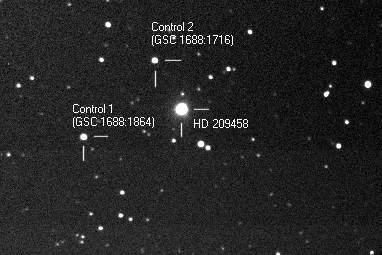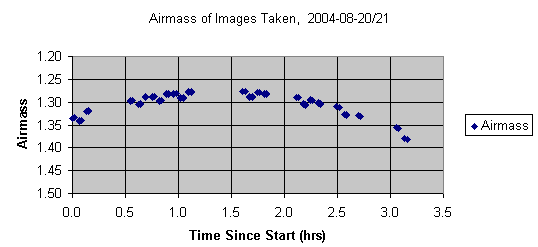David's Astronomy Pages
CCD Image Notes - Session 66 (2004-08-20)
Notes
(S54)
Notes
(Main)
Home
Page
Notes
(S71)
David's Astronomy Pages
|
Notes (S54) |
Notes (Main) |
Home Page |
Notes (S71) |
CCD Session S00066 HD 209458 Extra-Solar Planet Detection - Dry Run > Images from CCD Session 66
HD 209458 has a transiting Jupiter mass short period extrasolar planet.(HD 209458-b). Every 3.5 days, the planet produces a dimming of the star of 1.7 % that lasts for about 3 hours. The dimming has been detected by Castellano and Laughlin.
This level of dimming should be just about detectable using my telescope and CCD. However conditions will need to be ideal and my technique needs to be perfected. With the aim of making a future detection, an initial dry run was made on the night of 2004-08-20/21.
HD 209458 is shown in the picture below. This is as imaged through my 8" LX200 with focal reducer and ST7 CCD camera. The field of view is 16.1 x 10.7 arc mins.
| HD 209458 (Pegasus) |

|
|
CCD Image, 60 sec exposure ( Clear Filter) 2004-08-20 22:42h UT (#66031) |
HD 209458 has a magnitude of +7.70 in V. All the other stars in the field have a brightness of not less than +11.3, and none of these was considered as providing an acceptable reference star due to them being all significantly dimmer than HD 209458 and this which would lead to imprecise magnitude estimates for the brighter target star.
To overcome this it was decided to alternate images of the HD 209458 field with images of fields of nearby stars having more similar magnitude to HD 209458. Two fields were chosen for the initial dry run.
SAO 107613 lying ies 35 arc min
away
(containing +8.91 mag star SAO 107613 and +9.79 mag star SAO 107614)
HIP 108613 lying 43 arc min away
(containing +9.21 mag star HIP 108613 and +10.56 mag star GSC
1687:145).
[in theory it is possible to place HD 209458 and the +8.1 mag star SAO 107607 within the same field of field, however this can not be done reliably given the pointing/jogging errors on my LX200 telescope.
It was decided to image the fields in V and R bands with exposures of 20sec duration, and with 2x2 binning. Scripts were used to take 15 sec "Locate" images through clear filters which were image linked and if necessary used to jog the telescope scope onto the required target field.
55 images were taken through each of V and R filters across a period of 3 h 10 m. The images were intermixed with images of comet C/2001 HT50 which also lay nearby in Pegasus. Images were taken at a CCD Temperature of -15 deg C.
Raw Images were reduced using Dark Frames and Flat Frames. These support frames which were taken during the same session. A batch of 7x 20s Dark Frames were taken at the beginning of the session, with further batchs of 7x20s Darks taken in the middle of the session and again at the end of the session.
Images were initially analysed using my "VMA" Program (visual basic script that reads the reference file and analyses each image using CCDSoft/TheSky6 and calculate the instrumental magnitude of target stars, reference stars and control stars). The resulting tab delimited results file was then opened in MS Excel.
Only B and V magnitudes were available for the Reference Stars and therefore it was decided to concentrate the analysis on V filter images.
Figure 1 shows the Airmass of the images taken. Meridian was crossed approximately 1.4 hours into the observing run. Whilst it had been hoped to determine an extinction factor from the data, deterioration in sky conditions after only 1 hour of observations (due to build up of thin cloud) made this impossible. Without a measured estimate of Extinction an assumed value of 0.3 mag/airmass was used to allow for the small difference in airmass between HD 209458 and the Reference Fields.
Figure 1 |
The deterioration in Sky conditions caused a fall off in the
observed instrumental magnitude of all stars, including HD 209458. The effect on
the later can be seen in Figure 2.
|
Figure 2 |
To some extent the variation in sky conditions can be allowed for by using Zero-Point corrections derived from Reference Images taken shortly before and shortly after the Target Images. This assumes that change in sky conditions was completely gradual. In reality the change in conditions was not regular and this introduces uncertainty on the magnitude estimates made for later images.
Figure 3 shows the calculated zero point for each
reference star measurement (determined as V - vo, catalog
magnitude of the star in V band minus the exoatmospheric instrumental magntitude
in V Band). The graphs shows a clear change in Zero Point with time, with
highest ZP values indicating best atmospheric transparency and the lowest ZP
values indicate poorer atmospheric transparency.
To provide a best Zero-Point for calculating the magnitude of each target a 3rd
order polynomial function was fitted through the calculated zero points. This is
shown in the Figure 3 along with the ZeroPoint values actually used for
calculating the magnitude of HD 209458. As can
be seen there is a wider variation in calculated Zero Points after 1.5 hours,
which will inevitably lead to a wider uncertainty on calculated magnitudes.
|
Figure 3 |
Figure 4 shows the results of calculated V Magnitude estimates of HD 209458. It shows that the overall precision in magnitude estimate is only ~ +/- 0.1 mag. This was a lot lower than had been hoped, but can be accounted for by the variability in the sky conditions experienced. The precision achieved the dry run is a lot lower than the +/- 0.01 mag precision or better needed in order to detect the 0.02 mag dimming associated with the transiting extra solar planet.
|
Figure 4 |
Because images of HD 209458 were taken in pairs (separated by ~ 1 minute) a closer estimate of the potential precision achievable under more ideal conditions can be determined from comparing the magnitude variation shown between members of the 9 pairs taken (Figure 5). An analysis shows that the average magnitude difference between pairs is 0.024 mag, with range from 0.00 to 0.08 mag and 66% of pairs ( 6 of 9) having a magnitude difference of < 0.02 mag.
|
Figure 5 |
The dry run indicated that with poor/variable sky
conditions it will be impossible to detect the extra-solor planet HD 209458-B.
However the dry run provided encouragement that under good constant sky
conditions, it may be possible to get the required precision to detect the
extra-solar planet. .
Recommendations to increase chances of detection during a real event are
image in V filter alone, in order to increase the number of images than can be averaged together and thereby reduce magnitude uncertainty.
use reference stars that are an even closer match in magnitude to HD 209458 than those chosen in the dry run.
Back to Top
| This Web Page: | CCD Image Notes - Session 66 (2004-08-20) |
| Last Updated : | 2015-05-16 |
| Site Owner : | David Richards |
| Home Page : | David's Astronomy Web Site |